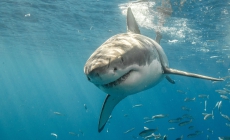-
Ten-Foot Great White Shark ‘Crystal’ Is Heading for Florida - November 7, 2023
-
A portion of Mulholland Drive, damaged by mudslides in winter storms, reopens - May 26, 2024
-
‘Maybe You Don’t Want to Win’ - May 26, 2024
-
Donald Trump Putting Law Enforcement in Danger: Attorney - May 25, 2024
-
Avoid the waters of these 5 L.A. County beaches this holiday weekend, public health officials say - May 25, 2024
-
Bawdy Comedy ‘Anora’ Wins Palme d’Or at Cannes Film Festival - May 25, 2024
-
Map Shows Heat Wave Zone Spread Into Five New States - May 25, 2024
-
Azusa police arrest suspected slingshot-wielding vandal - May 25, 2024
-
Donald Trump Hammers Judge Ahead of Jury Instructions - May 25, 2024
-
Sometimes U.S. and U.K. Politics Seem in Lock Step. Not This Year. - May 25, 2024
Ten-Foot Great White Shark ‘Crystal’ Is Heading for Florida
A 10-foot-long great white shark named Crystal is heading straight towards Florida.
The shark was tracked en route to the state’s waters by ocean research organization OCEARCH, which tags great whites to learn more about their behavior. Crystal was tracked near Florida on November 3, off the coast of Daytona Beach and not far from St. Augustine, both popular tourist hotspots.
Crystal was first tagged by OCEARCH in 2022, when it found her to be 10 feet long, and weighing 460 pounds.
Crystal is part of a population of great white sharks that migrate north to Canada for the summer months, before heading back down the East Coast towards Florida for the winter. Great whites are a solitary species however, and do not travel in groups. It is not unusual for the sharks to occasionally stray from this migration route.
“Most, but not all, species of highly mobile sharks in the Northern Hemisphere move southward in the winter as they are following their food,” Gavin Naylor, director of the Florida Program for Shark Research, previously told Newsweek.
“Indeed, food availability drives a lot of animal movement. Sometimes sharks move inshore to drop pups if they are live bearing or egg cases, if they lay eggs, to provide a more secure environment for their young.”

ShaneMyersPhoto/Getty
According to Naylor, due to white sharks’ large size, they have “thermal inertia.”
“This means they don’t ‘warm up’ or ‘cool down’ as much as would smaller animals, so temperature per se is less of a driver of movement than is food availability. If you look at multiple white shark tracks in the Northwest Atlantic, you will see that they are all over the place,” Naylor said.
Although Crystal is large, it is very unlikely that her presence in Florida will pose much danger to humans.
The sharks, while infamous for being aggressive, do not typically hunt humans. However, incidents can occur if humans are in the water at the same time the shark is hunting.
OCEARCH tracks numerous other great whites, some of which are much larger than Crystal.
Ironbound for example, is one such shark that measures 12 feet and 4 inches long, and weighs a ginormous 1,189 pounds. OCEARCH also tracks Breton, who measures 13-foot-long and weighs 1,400-pounds.
OCEARCH tracks white sharks to learn more about the elusive species’ behavior. There are a number of mysteries that remain unanswered, including where or how they mate.
So far, scientists believe they may mate off the coast of the Carolinas, as there have been several juvenile great white sharks seen in that area.
Do you have an animal or nature story to share with Newsweek? Do you have a question about great white sharks? Let us know via nature@newsweek.com.
Uncommon Knowledge
Newsweek is committed to challenging conventional wisdom and finding connections in the search for common ground.
Newsweek is committed to challenging conventional wisdom and finding connections in the search for common ground.
Source link
































